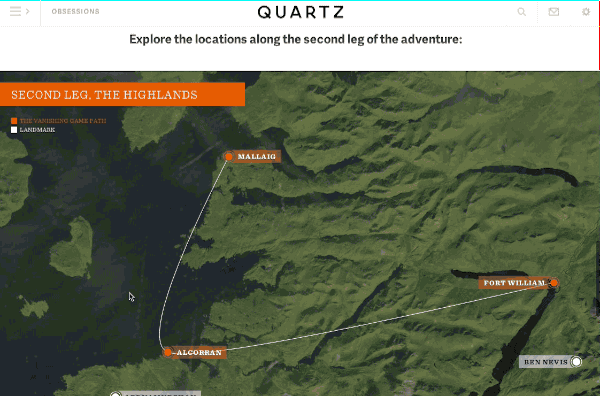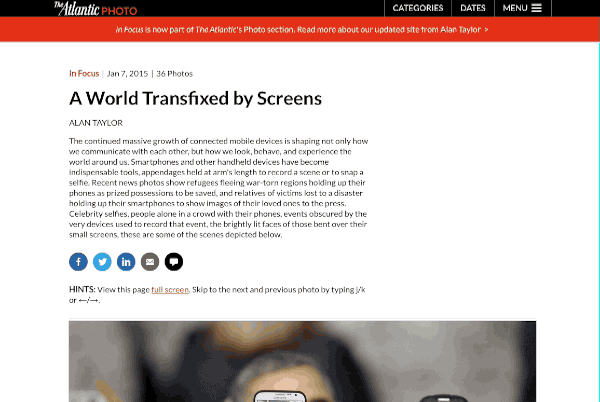
Quartz, Atlantic Media’s business news site, is known for pushing the envelope on page design and visualizations, but it’s also applying some of those lessons to its advertising products as well.
Its two ad units, the jumbo-sized “Engage” displays ads and its “Bulletins” sponsored content units, are both built around creating ad experiences that take cues from the site’s editorial content: The Engage ads, usually built by Quartz’s in-house creative services team, are designed to fit seamlessly with the articles around them, and Bulletin ads frequently feature visualizations and other interactive elements, which Quartz has become known for. Quartz’s thesis isn’t that there isn’t a place for display ads online but rather that those ads have to be contextual, both in form and content, with everything else.
“Finding an compelling way to engage with audiences across devices and fit in naturally with their expectations is a tall order. We’re always thinking about our end-user,” said Quartz executive marketing director Marissa Hayes Aydlett.
Brands like what they hear. The site worked with 80 brands in 2014, including GE, Land Rover and U.S. Trust. Land Rover, for example, tapped Quartz for a story on the Scottish Highlands, which included interactive maps that let readers learn about locations in William Boyd’s “The Vanishing Game.” GE also used an interactive chart for a campaign about medical care in India, which tied to a larger series on GE’s role in promoting innovation in the country.
“I think what’s most compelling about the formats is the variety of storytelling tools they can employ — variety that matches the tack taken by the QZ editorial, and hence makes the branded content additive to the overall experience,” said GE global director of media strategy Jason Hill, who added that GE will continue working with Quartz this year.
Ultimately, Quartz is in a unique, fortunate spot among publishers. While legacy media brands, and even early digital-first ones are trying to retrofit their pages and business models to accommodate new ad formats and the rise of mobile, Quartz was designed from the get-go with those shifts in mind. Its Engage ad units, for example, are designed in HTML5, which lets them scale for the screen size — mobile, tablet, desktop, etc. — that they’re viewed on.
It is also taking a pragmatic, moderate approach to the native vs. banner ad debate that too frequently rages. Sites like BuzzFeed and Mic have painted display ads as the enemy. But for Quartz, display ads don’t have to be terrible. They just need a lot more attention — and, crucially, fit in well within the environment. By comparison, compare the seamlessness of Quartz display ads with the standard ads awkwardly interspersed into fellow Atlantic Media property TheAtlantic.com’s new photography section.
Of course, the biggest challenge for Quartz is being able to scale the creation of these custom ad products. While it’s in vogue for the industry to pile on the inefficiencies of display advertising, standards are inherently easier to scale than custom ad products, which fuels their popularity. Create one standard banner ad and its trivial to get it running on any other site on the Web. Quartz’s Engage ads don’t quite have that pull.
This, in turn, puts pressure on Quartz’s staff, which needs to scale up to meet increased advertising demands. Aydlett said that Quartz doesn’t share publicly how many designers, programmers and content writers it employs in its custom content division. “It’s a sophisticated but nimble team,” she said.
More in Media

Meta AI rolls out several enhancements across apps and websites with its newest Llama 3
Meta AI, which first debuted in September, also got a number of updates including ways to search for real-time information through integrations with Google and Bing.

Walmart rolls out a self-serve, supplier-driven insights connector
The retail giant paired its insights unit Luminate with Walmart Connect to help suppliers optimize for customer consumption, just in time for the holidays, explained the company’s CRO Seth Dallaire.

Research Briefing: BuzzFeed pivots business to AI media and tech as publishers increase use of AI
In this week’s Digiday+ Research Briefing, we examine BuzzFeed’s plans to pivot the business to an AI-driven tech and media company, how marketers’ use of X and ad spending has dropped dramatically, and how agency executives are fed up with Meta’s ad platform bugs and overcharges, as seen in recent data from Digiday+ Research.







